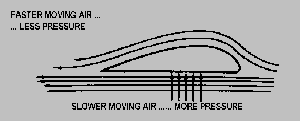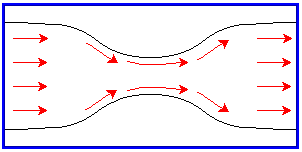Concerning flight, Bernoulli's Principle has to do with the
shape of an airplane's wing. The bottom is flat, while the top is
curved. Air travels across the top and bottom in the same time, so air
travels slower on the bottom (creating more pressure) and faster on top
(creating less pressure). This supposedly keeps the plane in the air.
This is used to explain flight in a simplified manner. You can
find the Bernoulli Principle as the explanation for flight in such
common references as Suplee, C. (1996). "Everyday science explained."
Washington, D.C.: The National Geographic Society (pp. 54-55). However,
it came to our attention (thanks to Ron Wyett) that more subtle
thinking about the aerodynamics of flight has taken place, and below,
we link to some resources for that.
"How Airplanes Fly: A
Physical Description of Lift (PDF)", written by David Anderson and
Scott Eberhardt for Sport Aviation Magazine, provides a beginning to
understanding flight. This article begins:
- "Almost everyone today has flown in an airplane. Many ask
the simple question "what makes an airplane fly?" The answer one
frequently gets is misleading and often just plain wrong. We hope that
the answers provided here will clarify many misconceptions about lift
and that you will adopt our explanation when explaining lift to others.
We are going to show you that lift is easier to understand if one
starts with Newton’s laws rather than the Bernoulli principle. We will
also show you that the popular explanation that most of us were taught
is misleading at best and that lift is due to the wing diverting air
down. Most of this diverted air is pulled down from above the wing." Go to
this article.
The following is a more in depth description of Bernoulli's
Principle.
Daniel Bernoulli, an eighteenth-century Swiss scientist,
discovered that as the velocity of a fluid increases, its pressure
decreases. How and why does this work, and what does it have to do with
aircraft in flight? Discuss this in your group and write a list of
things that you already know and a list of things that you would like
to learn. Share your lists with other teams and with your teacher. Here
is some more information about Bernoulli's principle

Bernoulli's principle can be seen
most easily through the use of a venturi tube (see Figure below).

A venturi tube is simply a tube which is narrower in the
middle than it is at the ends. When the fluid passing through the tube
reaches the narrow part, it speeds up. According to Bernoulli's
principle, it then should exert less pressure. Can you explain why this
happens? Here are some ideas to discuss in your group.
• What happens
to the energy of the fluid as its speed increases?
• What
happens to the pressure that is exerted by the fluid as its energy
changes?
Here are some things that explain the flow of the liquid in the venturi
tube:
As the fluid passes over the central part of the tube, shown in Figure
to the right, more energy is used up as the molecules accelerate. This
leaves less energy to exert pressure, and the pressure thus decreases.
One way to describe this decrease in pressure is to call it a
differential pressure. This simply means that the pressure at one point
is different from the pressure at another point. For this reason, the
principle is sometimes called Bernoulli's Law of Pressure Differential.
Since Bernoulli’s principle applies to fluids and air being one of
them, we can explain the relationship between air velocity and pressure
on the surfaces of an airfoil.
Here are two simple experiments to investigate how an aircraft
wing reacts with the atmosphere.
1. An airfoil
experiment
2. An experiment to show how lift is
created by the application of Bernoulli's Principle



